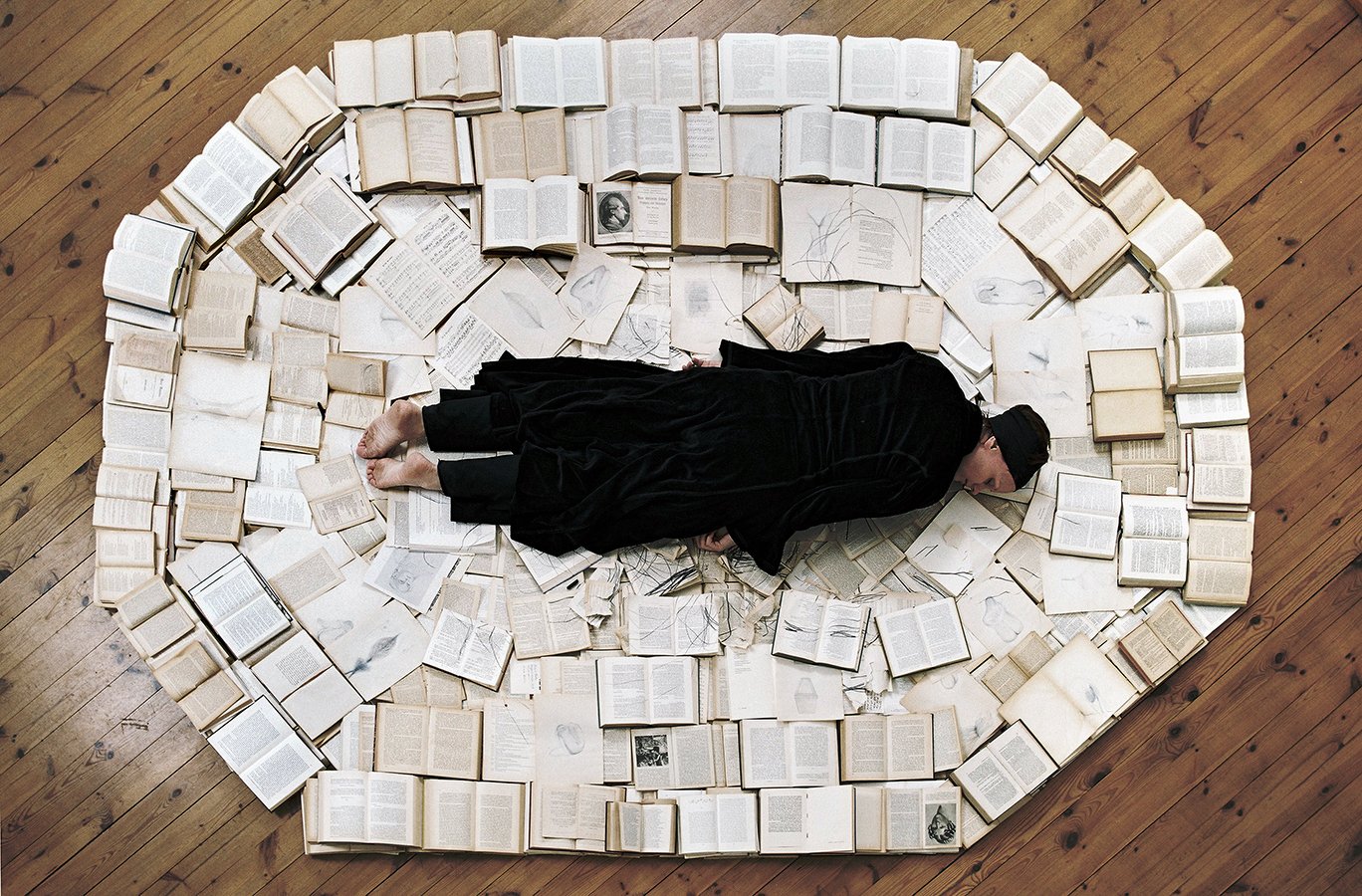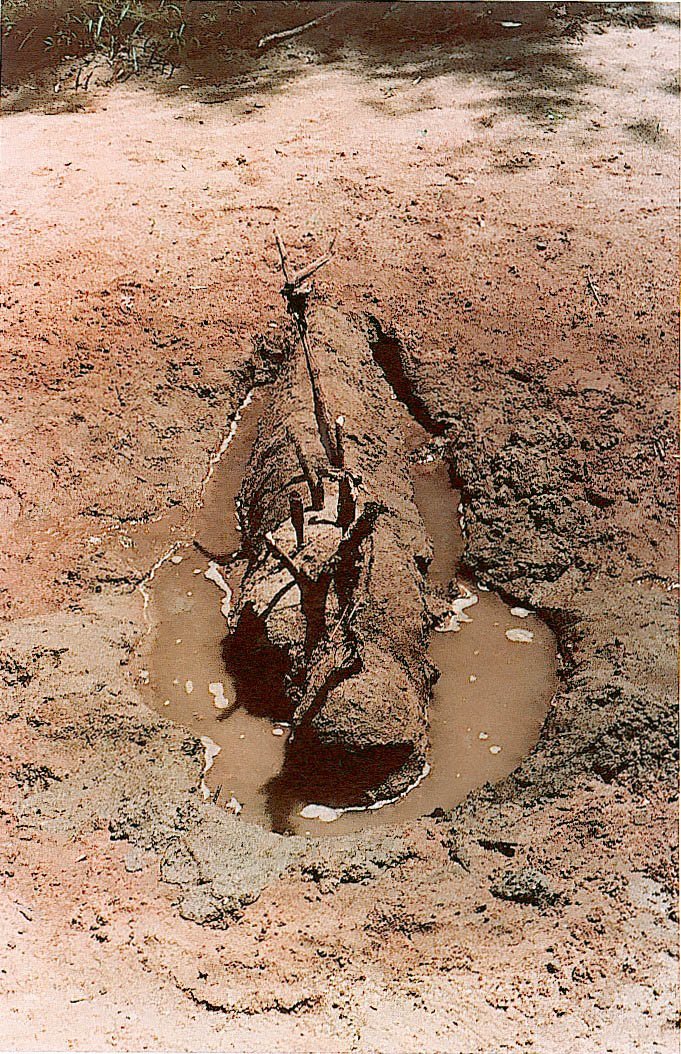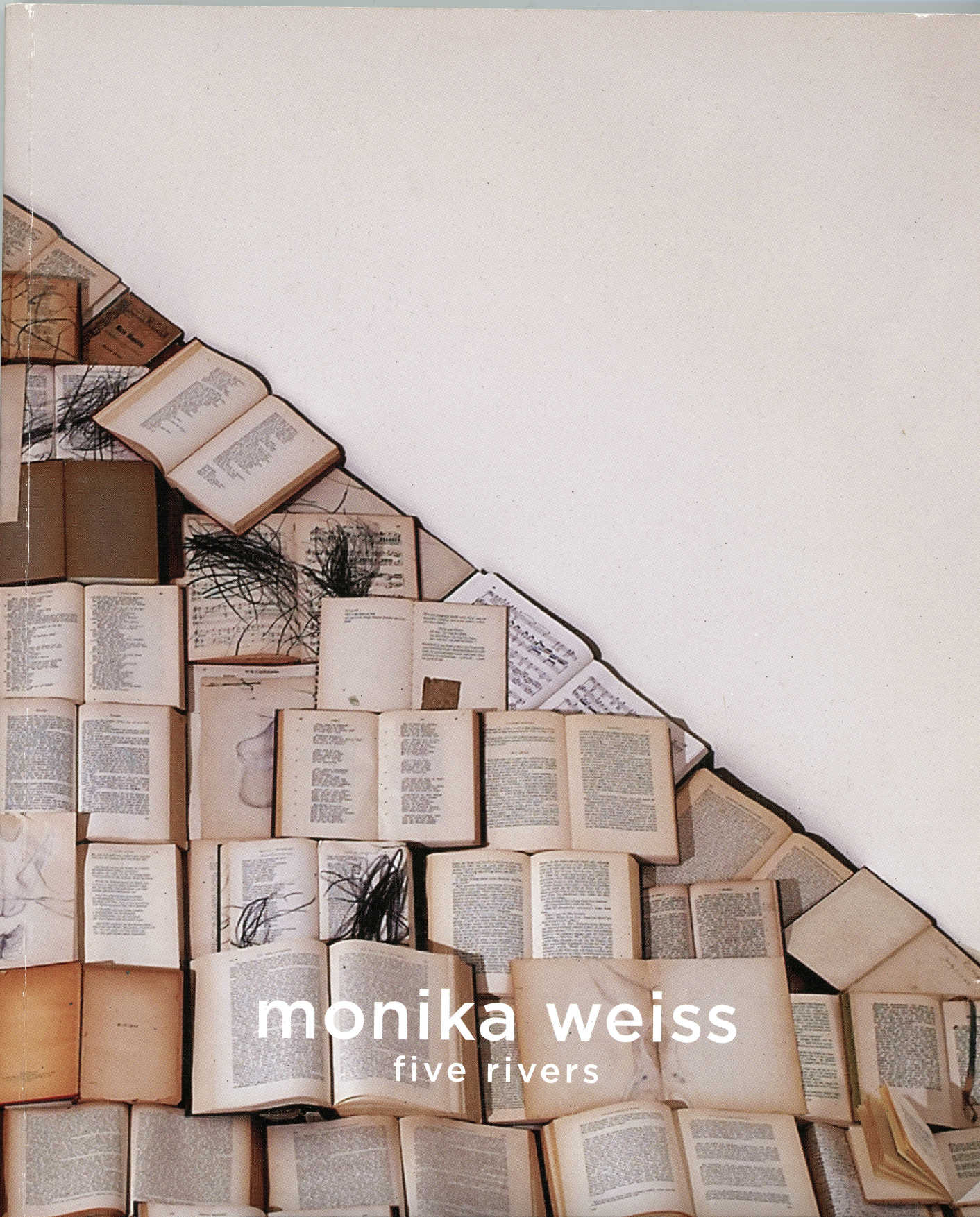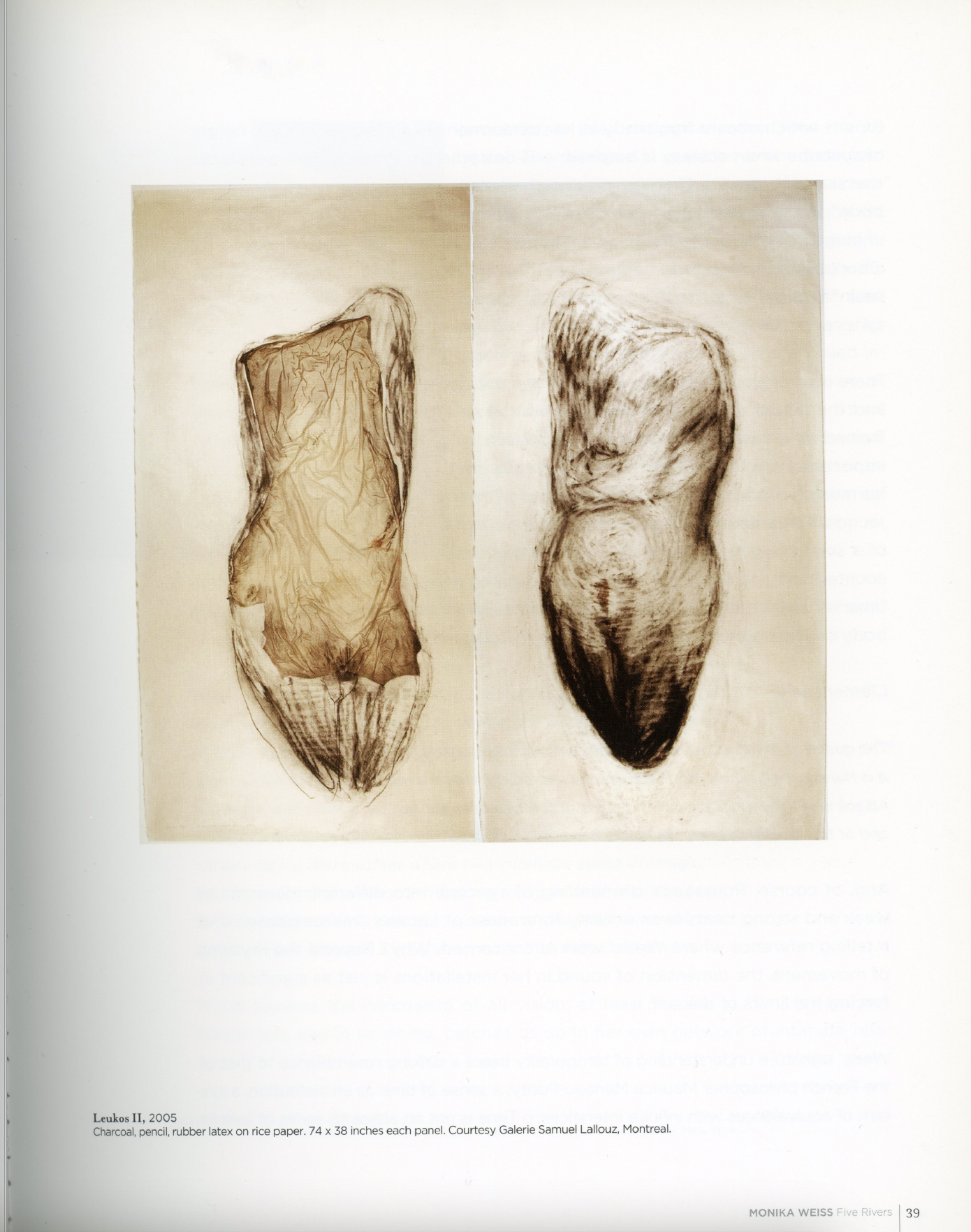Guy Brett
Time Being
by Guy Brett
in The Crossing of Innumerable Paths: Essays on Art, Ridinghouse, London, 2019
in Monika Weiss: Five Rivers, Lehman College Art Gallery, City University of New York, and Galerie Samuel Lallouz, Montréal, 2007
Before it was named as such, and thereby threatened in its very vitality, ‘performance art’, or ‘live art’ exhibited one of the great creative desires of the 20th century, the drive towards interdisciplinarity, or to use a more physical metaphor, towards the cross-breeding of genres and expressive systems. This allowed, for example, the dramatic action associated with theatre to mingle with the contemplative time of the painting, sculpture or drawing. Something new was created: each changed the other. The new work could retain theatre’s sense of witnessing a happening but dispense with narrative and plot. It could retain painting and sculpture’s silent materiality while rendering it sentient and ephemeral. In Monika Weiss’s work there is a ‘stage’, but it is extraordinarily contained: a chalice, a font, a concrete sarcophagus, layers of books, a portion of the street. Action is minimal and everything works towards the intensification of human presence.
Numerous statements of hers attest to this. “During my actions my eyes are closed ... I am in a state of maximal concentration.” “Economy of motion emphasises act of composition – the isolation of body.” “I provide space for observation of delicate, small, and often slow changes”. And finally, “Everything is performative, in a continuous state of becoming.” [1] In her work the body is not ambulatory. It doesn’t go anywhere. It moves only within its own reach. It endures, laments, blooms. Its spatial element is restricted to expand the experience of time.
As well as cultivating intensity within prescribed limits, her work muses philosophically on the nature of space in the most general terms. For example, the notions of the horizontal and the vertical. Their relationship is obvious but at the same time deeply mysterious. In several of Weiss’s video/performance installations visitors take in the scene from their normal standing or sitting position. From a vertical viewpoint they see the horizontal body of the artist, lying in a concrete container or vessel, or on the floor on a layer of books.
At the same time a camera films the artist from directly above, and this horizontal image is then projected vertically, sometimes in another room. To the spatial experience is added the cinematic, in which not only is the live action mediated by video but may be manipulated in time according to whether the projection is a direct transmission or an edited version. The tension between live body and spectral image is beautifully suggested in White Chalice (Ennoia), 2004, by the projection of the naked, curled-up body of the artist directly into the waters of the receptacle.
One has the impression that of all these spatial orientations it is the view from above which really engages Weiss’s attention and resonates most strongly in her work. By a fertile paradox, the vertical view intensifies the act of lying down. It emphasises gravity, heaviness, attachment to the earth while suggesting levitation and flight. And here perhaps the image made possible by visual technology connects with experiences reported in dreams since time immemorial of leaving the body and looking down on oneself from a great height. “Images of flight and ascension are metaphors for transcendence and spiritual freedom. In this sense, the dream of flying, which implies a desire to abolish time and space and to unify matter and spirit, is a basic part of human nature, symbolising the need, and perhaps the possibility, of becoming free from all conditioned limitations.” [2]
Parallel with its dream connections, and strange as it may seem, the act of lying down is woven into political and cultural struggles which are urgent and contemporary. Monika Weiss has said that for her lying down is an “ethical stance”. [3] She refers to “’letting go’ in a symbolic way ... as opposed to the physical posture of ‘marching soldiers’”. Again, in more personal terms, she says: “I am interested in overcoming the idea of creativity as aggressive power, towards creativity which is close to melancholy, surrendering, humbleness and smallness”. [4]
A fascinating genealogy can be constructed of women artists who have valorised the act of lying down as a critique of patriarchy, and as an apparently humble act that conceals a great strength. Examples come from many parts of the world, with many shades of metaphor. In Buenos Aires in the 1970s, Marta Minujin constructed a replica in wood of the Obelisco (Argentina’s equivalent of the Washington Monument) lying on its side in a vast exhibition space. She said: “Everything is so straight and rigid and perpendicular that I want to make it all lie down . ... [the Obelisk] represents the hard part of society.” [5]
In the 1960s in Sweden, Niki de Saint Phalle (together with Jean Tinguely) constructed her Hon - en Katedral (She cathedral), a huge joyful female effigy lying on its back which visitors could enter through the vagina. By identifying a woman’s body with a cathedral, Niki de Saint Phalle found a way of expressing sacred space as a “collective ideal”. Ana Mendieta’s Siluetas, recumbent female effigies made by bringing together, or taking away, natural elements particular to any outdoor site, an effigy left to disintegrate and return to the earth it was made from, exhibit a similar sense of slow-moving intensity as Monika Weiss’s performances, a degree of artistic concentration which draws in every material nuance of the surroundings. In very different circumstances, women anti-war protesters, encamped around the US Cruise Missile base at Greenham Common in southern England in the 1970s, lay on the ground and used string weighted down with stones to tie themselves to the site, which was in fact, according to ancient tradition, common land. The string looked frail but its symbolic charge was unmistakable.
Ana Mendieta’s Siluetas were made in a solitary ritual and recorded by the artist or a photographer friend. This distancing may contribute to the power of the resulting image by the very fact of being removed from the event itself. The uniqueness of the chosen patch of ground is strongly communicated and at the same time generalised.
Monika Weiss consciously explores this kind of ambiguity by playing live event against the video image. In Phlegethon – Milczenie, 2005, there were two identical rooms. In one she performed several times, lying on a pallet of open books – philosophical and literary publications from pre-war Germany – and drawing around her body. In the other room a continuous video was projected, based on the performance, although the artist herself might no longer be physically present.
Her videos are very minutely edited, an intervention in time flow she feels she can only do herself, in a hands-on process in front of the screen. “I take specific fragments from the many hours of footage and then compose a new story, sometimes interrupting the chronology of events, mixing past and present with each other. Sometimes I incorporate visual commentaries (such as views of sky, river, fire and earth) [...] “I edit instinctively with a deep focus and profound emotion ... similar to the way I draw”. [6]
The linking of drawing with the editing of video is another particular characteristic of Monika Weiss’s work. Both have a very personal touch, and, in both, the result is to create not so much a depiction as a presence. The video image is not ‘of’’ her, but seems to arise from her own offering of herself, the result of some alchemy between the unmanned camera’s “surveying, cold, motionless eye” [7] and the emotion brought to the editing process. The birds-eye view serves to create a site, a space, separated from the rest of the environment, a graphic world. On the horizontal plane the body’s movement itself takes on a graphic quality: “Outside the world and inside the drawing”. [8]
In Drawing the City, 2005, which took place on sheets of canvas spread on the pavement across from the Hudson Valley Center for Contemporary Art in Peekskill, NY, with traffic only a few feet away but invisible, local children join the artist lying down and draw around their bodies. They enter and leave the arena as they wish, little bundles of energy which, thanks to the telescoping of time by the editing process, and the use of dissolve, can simply materialise in the scene, or fade away. They can appear ephemeral against the materiality of the drawing. Drawing is the connecting thread between the technological and the corporeal aspects of her work, the theatrical and the plastic, the communal and the intensely solitary. Indeed her sensibility may be present in its purest and darkest form in the fleeting phantoms of her large- scale charcoal drawings.
Sound joins the ensemble of the spatial, material and graphic worlds of her installations in a further complex process of editing. In her latest work, Rivers of Lamentation, 2005, vocal lines from Gluck, Monteverdi, Purcell, Handel, Bach and Part, which she altered and combined and then mirrored with their own versions, contribute to the powerful evocation of mood which characterises all her work. How to describe this quality? The musical fragments in the new work are all forms of lament and the visual associations enlarge the feeling of sorrow and loss: the fall of the body in the pieta, burial, immersion in a foreign medium, whose attraction she would universalise: “We crave the coldness and wetness of the dark dirt and the earth – to lie down on or in it, to enshroud our tired body, to rest”. [9]
When I visited Monika Weiss in her studio in New York something in her work compelled me to utter the name Grotowski, even though I knew very little about the work of the great Polish dramatist. The name struck her and later she went to read or re-read his writings, translating for me some passages from Polish which seem penetratingly apposite to her own art:
“An act of creation has nothing to do with either external comfort or conventional human civility. It demands maximum silence and a minimum of words, boundless sincerity, yet disciplined, i.e. articulated through signs. Making art is not a state but a process, a slow, difficult upheaval, where what is dark in us, becomes gradually light”. In Towards a Poor Theatre he wrote: “Human body, the breath, the internal impulses, all can be used to be uncovered, to surrender to something, which is infinitely difficult to name, but where Eros and Charitas live.” [10]
If these phrases indicate a form of thinking or sensibility which can be described as ‘Polish’, they also may be seen as particular inflections of states of dilemma and yearning which affect all of us. Artists and writers in the Chilean Avanzada movement in the 1970s developed forms of visual-literary performance under the nose of the Pinochet dictatorship. Vulnerable to arrest and torture, the body was seen as the most real and honest site for expression, as “the ultimate value”, in the words of the artist and writer Diamela Eltit. [11]
In less extreme circumstances the valuation of the body that Monika Weiss achieves in her unique fusion of media is similar, I believe. We realise that her ‘slow time’ always takes place within the ‘hurry time’ which increasingly moulds our daily rhythm. Weiss provides an alternative experience of space and time, which is not end-driven but steady and enduring, establishing and deepening a human presence in the Grotowskian sense, and seeking “states of being outside time, where there is no beginning, middle or end, in an ongoing state of initiation.” [12]
Guy Brett, London, 2005
Notes:
[1] Monika Weiss in conversation with Aneta Szyłak, WYSPA Institute of Art, Gdansk, Poland, March 23 2005.
[2] David Coxhead and Susan Hiller, Dreams: Visions of the Night, London: Thames & Hudson, 1976, p.44.
[3] Monika Weiss, letter to the author, July 2 2005.
[4] In conversation with Aneta Szyłak, op. cit.
[5] Marta Minujin, quoted in Richard Squires, “Eat Me, Read Me, Burn Me: the Ephemeral Art of Marta Minujin”, Performance (London), summer 1991, p.20.
[6] Monika Weiss, email to the author, September 24 2005.
[7] Monika Weiss, in conversation with William Anastasi, Monika Weiss Vessels, New York: Chelsea Art Museum, 2004, p.14.
[8] Monika Weiss, email to the author, September 26 2005.
[9] Letter to the author, July 2 2005, op. cit.
[10] Jerzy Grotowski in Zbigniew Osiński, Jerzy Grotowski: źródła, inspiracje, konteksty (słowo/obraz terytoria), Gdańsk 1998
[11] Diamela Eltit, quoted in Nelly Richard, Margins and Institutions: Art in Chile since 1973, (Melbourne: Art & Text, no 21, special issue, May-July 1986).
[12] In conversation with William Anastasi, op. cit., p.19.
Guy Brett
Guy Brett (1942–2021) was an English art critic, writer and curator. He has written extensively on the visual arts since the 1960s and has organised a number of notable international exhibitions, including “Force Fields: Phases of the Kinetic” (MACBA, Barcelona and Hayward Gallery, London, 2000), “Li Yuan- chia” (Camden Arts Centre, London and touring, 2001) and “Boris Gerrets” (Kiasma, Helsinki, 2002). His books include Through Our Own Eyes: Popular Art and Modern History (New Society,1986), Transcontinental: Nine Latin American Artists (Verso, 1990), Exploding Galaxies: The Art of David Medalla (Kala Press, 1995), Mona Hatoum (Phaidon, 1997), Susan Hiller: Recall (Baltic, 2004), and Carnival of Perception (inIVA, 2004). In 2005 he was Peggy Rockefeller Visiting Scholar at the David Rockefeller Center for Latin American Studies, Harvard University. In 2019 he co-curated with Michael Wellen at Tate Modern, London, an exhibition of the work of the Greek artist Takis, the first substantial showing of the artist’s work in Britain since the 1960s. His The Crossing of Innumerable Paths: Essays on Art was published by Ridinghouse (London, 2019), with 14 essays devoted to artists Ana Mendieta, Dias & Riedweg, Javier Téllez, Jimmie Durham, Monika Weiss, Len Lye, Gianni Colombo, Liliane Lijn, Gego, Anne Bean, Aubrey Williams, Victor Grippo, Peter Kennard and Lygia Pape.




